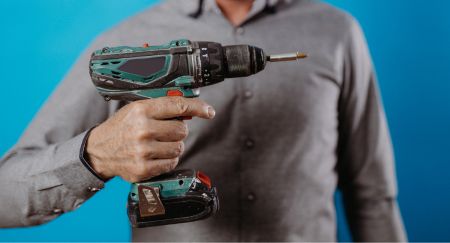Handy Hints
5 Cordless Drill Problems to Avoid
There is no doubt that a cordless drill is the best investment you could make if you do a lot of DIY and renovation. Compact, lightweight and portable, these tools can be used for just about every basic project under the sun. Whether you use yours for small tasks such as hanging up pictures and doing woodworking projects or you love taking on bigger projects such as retiling bathrooms or fitting cabinets in kitchens, a cordless drill allows you to get things done easily. One challenge of using any power tool on a regular basis is that it can suffer wear and tear over time.
If you use your tool often but don’t know too much about the technical side of power tools, you might be wondering what is happening when your drill suddenly stops working properly. In this article, we’ll share some of the most common problems (and how to solve them).
Common Cordless Drill Problems
A few of the issues you may encounter when using your cordless drill include the following:
Your drill is overheating
This is easily one of the most common issues that you could run into when using your drill. Drills overheat for several reasons. Often, this happens when you use the wrong drill bits, which puts excessive pressure on your drill as it tries to get through material that is too tough. Not using coolants and lubricants when drilling can also result in overheating - especially during drilling metal, masonry and other hard material. Non-stop drilling without taking any breaks can result in overheating, too. Drilling at the wrong angle or using worn bits will also increase the risk of overheating. If you notice smoke coming from your bit or feel your drill starting to get hot, stop drilling immediately to investigate the problem. You can then continue once you’ve had a better look at what is causing the drill to overheat. Do not ever continue drilling when your drill gets too hot. This can pose a major safety hazard, resulting in serious injuries. It can also damage your drill beyond repair.
Your drill batteries are flat
Drill batteries need to be maintained, just like the rest of your drill. In cold weather, drill batteries can freeze. Batteries can go flat over time with regular use. If you use too much force when you drill, you may find that batteries do not last as long as they should. If you use your drill for heavy-duty drilling on harder materials such as masonry, you will also find that batteries may go flat. Investing in a good-quality drill will go a long way in maintaining battery life, ensuring a long lifespan without the need to replace batteries often.
Your drill is losing power
If you’ve noticed that your drill doesn’t seem to be working as well as it usually does, it is likely losing power. This isn’t always battery-related. Although you can expect older drills to slowly start to wear out, wear and tear is more commonly related to poor maintenance. You may have started out cleaning your drill after using it, only to get a little slack. You may not be getting it properly serviced if you notice any small signs of wear. Letting small problems slide will result in larger problems when your drill has to keep using more power to get things done. Soon, you’ll notice overheating or malfunction. Keep your drill maintained to make sure that it runs properly.
Your drill bits aren’t fitting
The drill bits you use in your drill can have an effect on performance, too. Using bits that don’t fully fit will increase the risk of slipping - something that can pose a serious risk to your tool and to your safety. Bits can also be more likely to get stuck or your drill may be more likely to overheat. Using the wrong bits for the material you are drilling can also cause damage - in some cases irreversible. Choosing quality drill bits from trusted manufacturers such as Ruwag makes it easier to use bits that are made for the correct material and application. Using the right size bits is equally important.
Your drill parts are worn
Finally, another issue is worn drill parts. This is why you need to look after your tool and get it serviced on a regular basis. Worn parts can cause damage over time. In some cases, you may not notice that things are getting worse until the drill malfunctions completely. If a part is worn and you keep using the drill, you may end up using more force, which causes even more damage. Take your drill in for a service, and make sure that you keep it maintained.
We hope that these tips help you get the most from your tools so that you can enjoy your cordless drill for many years to come, whatever projects you have planned.


